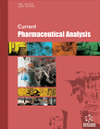-
s Analytical Techniques for DNA Methylation – An Overview
- Source: Current Pharmaceutical Analysis, Volume 10, Issue 1, Feb 2014, p. 71 - 85
-
- 01 Feb 2014
Abstract
DNA methylation is the most common epigenetic tool used by cells to express or silence a gene. Methylation is observed when there is an addition of methyl group at position 5 of cytosine pyrimidine ring or at nitrogen present on 6th position of adenine purine ring. It plays a vital role in many aspects of biology including development and disease. A revolution has been witnessed in DNA methylation analysis technology over the past decade, analysis earlier restricted to specific loci can now be executed on a genome-scale and entire methylomes can be characterized at single-base-pair resolution. Methylation can be detected using bisulfite conversion, methylation sensitive restriction enzymes, methyl binding proteins and anti-methylcytosine antibodies. No single method of DNA methylation analysis is appropriate for every application. By understanding the type of information provided by and inherent potential for bias and artifacts associated with each method, investigators can select method most appropriate for their specic research needs. This article is focused on brief knowledge about DNA methylation, several techniques developed so far and advantages and disadvantages of such techniques.


